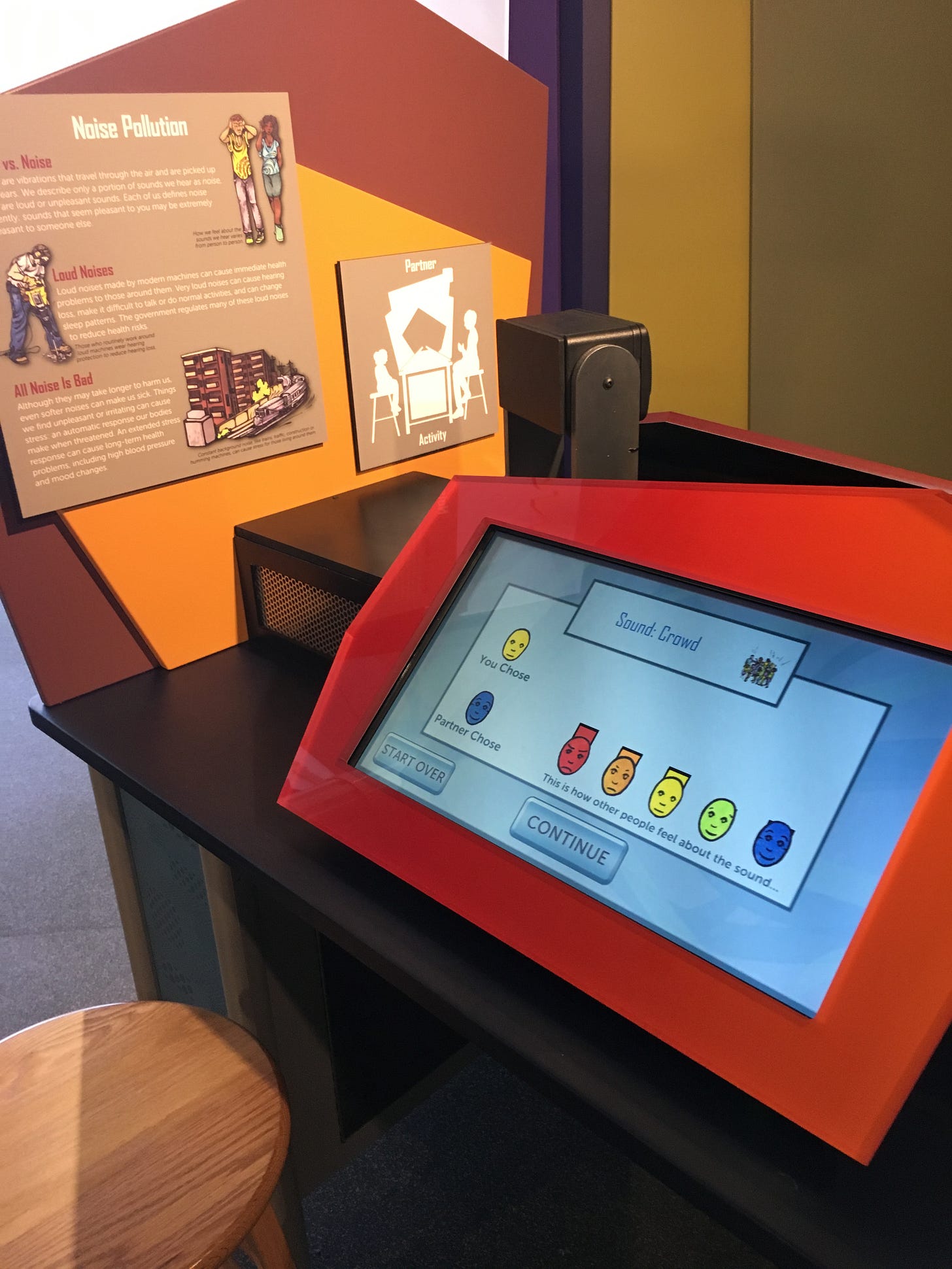My last post mentioned that sound is a great prompt for visitor or community engagement. A soundscape is information about the current built environment and thinking about that soundscape can get people in a frame of mind to think about how they might want that built environment changed in the future. Today, I look at the “squishier” side of sound. Yes, it can be measured and analyzed, and it is data. But sound is also processed emotionally, and that became the theme of a second sound-based interactive in the City Science exhibit.

Sound, Noise, or Pollution?
As I mentioned in Sonic & Civics Part 1, our exhibit team discovered the people’s auditory experience of our city varied with their zip code. This wasn’t just a matter of what sounds you hear in your neighborhood, or even how loud they were. Our perceptions of sound and noise seem to be based on individual life experience, rather than absolute decibels. It was a focus group discussion with the local food justice organization (shout out REC!) that alerted us to this. Participants offered specific stories: the cousin from New York City who couldn’t sleep while visiting Worcester because it was “too quiet”. And brought up the fact that loud classical or rap music could be “awful noise” depending on your musical taste. (Witness the late 20th Century practice of blasting classical music to deter teens from hanging out in shopping plazas.)
So, we tested this out with museum visitors, and the result was the “Noise Pollution” interactive. At the interactive, two visitors face each other, and take turns playing different sounds. They each rate the sound by how pleasant or annoying it is, then compare their responses. It was fascinating to have teens from the same high school discuss whether the sound of a siren meant “Cr@p! The cops are coming.” or “Help is on the way.” One tween exhibit tester surprised us - and her friends - by liking the sound of a crying baby because it reminded her of her baby cousin. In fact, those visitor discussions exploring each other’s perspectives became the main point of “Noise Pollution.”1
Noise and Public Health
Unbeknownst to us, while we were designing and building our exhibit, epidemiologist Erica D Walker was biking around Boston neighborhoods, measuring noise levels at 400 sites AND surveying residents about their perceptions of nuisance noises. And, as we had found anecdotally, Dr. Walker found in her doctoral research that people’s perceptions of sound, especially the feeling that some sounds were harmful, were not directly correlated with absolute loudness. But, as she points out in this article describing her research, the body feels the health impacts of noise pollution, regardless of our conscious perceptions. I highly recommend digging into her Community Noise Lab and her research which goes beyond simple decibel measurement to include frequencies above and below our hearing. (By the way, no longer reliant on bicycling doctoral candidates, some cities are deploying sound sensors to monitor noise pollution. )
If I were crafting a new engagement activity around sound, I would share some of her findings with participants, to help drive home that sound and noise in our cities are health and justice issues. I’d also include information from this piece on inequity in noise pollution impacts and enforcement by the Noise Project, a community science project by Cornell Lab of Ornithology and community-based organizations. And, just as with heat islands, the distribution of the worst noise pollution correlates with redlining.
The Rarity of Quiet
Right after I had this piece put to bed, I saw this piece Are Quiet Places Going Extinct? on CBS News. The story highlights the work of the all-volunteer Quiet Parks International which works to preserve the places on Earth still free from human-generated noise. It flips the “sound is data” idea on its side, raising the point that purely natural soundscapes are rare and vanishing. Well worth the five-minute watch.
And! Another Museum Blog Piece About Sound
I swear, as soon as I’ve written a piece and packed it up in its Substack package, I see story after story on the same topic. First the CBS story, now Cheryl Fogle-Hatch of Museum Senses has written this wonderful blog piece, The Power of Sound: Sonification and Soundscape. Not only is her piece well worth the read, Cheryl is worth a follow to learn more about work in researching and developing multisensory experiences in galleries, museums, and other cultural organizations to fully engage people who are blind and those without visual disability.
A Museum-y Sound Project to Follow
Finally, if you’re interested in the impact of sound on the visitor experience and learning in informal STEM settings like zoos and science museums, keep an eye out for TERC’s research project Sound Travels. It’s early days for the project, but their Learn More page has some cool resources, especially around acoustic ecology.
As always, here is my call to you. If you’re doing a project that examines noise and sound, or any project that sits at the intersection of museum and planning practice, please let me know!
~ Betsy Loring2
The Planning-Curious Museum Person
Sharing stories and ideas for other Planning-Curious Museum People and for Museum-Curious Planning People. Interested in expLoring a collaboration with me? Let’s talk!
Ironically - and shamefully, the sound interactives are not very accessible to visitors who are blind or have low-vision. Don’t we all wish we had a time machine to correct past projects?
Betsy Loring is founder of expLoring exhibits & engagement. She has over 20 years’ experience in project management and exhibit development in multidisciplinary, indoor and outdoor museum settings. Her services include exhibit master planning, content and interactive development, and writing, with a focus on hands-on STEM. She also offers staff training in exhibition planning, formative evaluation, and prototyping. Special interests include multi-institutional collaborations, peer-to-peer professional development, and of course – collaboration with municipal planning practitioners.



